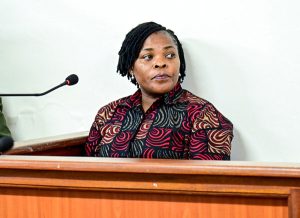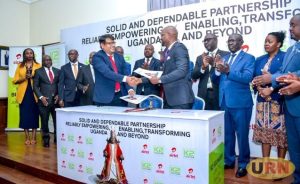‘Census 2024 data is the richest ever for Uganda’

Dr Mukiza (middle) interacts with journalists at the media breakfast on Tuesday in Kampala.
Kampala, Uganda | LOUIS JADWONG | “We have the most comprehensive census data ever collected in Uganda,” a statistician of the Gen Z Generation who works at UBOS, has assured The Independent.
In his mid-20s, and likely one of the youngest at UBOS – the principal data collecting, processing, analysing and disseminating agency – he told The Independent that he was confident that the hitch that saw figures for several tribes mixed up will be forgotten, once they show the public the processes they used to come up with the latest information. “We captured all tribes and have all their details, there is nothing to hide” he said confidently.
“The data got mixed up, but it is us internally who spotted it first and we have now corrected it. We have delayed to release the corrected version because once bitten, twice shy….we are combing through it to make sure all our data matches,” the young man who refused to be named said. It was a chance meeting in a Kampala sub-urb, as The Independent sought answers to several questions, after learning he worked at UBOS.
The census results, he assured, are richer than ever before. They include literacy rates, school attendance and education attainment, health indicators, Employment and unemployment concerns, religious affiliation and marriage trends among other things.
He listed five key areas the census results will benefit the Ugandan government. ” They will know how many Ugandans we are, where we are, how we are living, what we own and where we access services from.”
The census process they adopted, he said, has in-built mechanisms to deal with errors. He said there was an initial mapping of census zones, that was matched with the actual census, and after that a mopping of the areas not covered.
He said it caters even for those who were not counted. “They are all accounted for in our statistics,” he bragged.
Asked if the method used, with new gadgets was not problematic, he replied, ” Head count gives the most accurate data. We cannot rely on sampled data as the method of choice. We actually sampled a few districts, during the pre census activities and this only helped to highlight issues that we would face and what needed to be improved to give out a seamless census.”
Dr Sennono reassured media that UBOS will work closely to ensure census results are fully understood
At a media breakfast Tuesday, Dr Ssenono Fred- Acting Deputy Executive Director reassured about the mix up on tribes including the Bagisu and Acholi. “We captured all tribes and have all their details. There was no intention to discredit other tribes, but there was only a Swap or mismatch of data where right data was put on a wrong tribe,” he told media.
He also clarified that no religion or faith had a decline in its faithful, but rather all religions have an increase but some are growing at a decreasing rate.
@ DR Ssenono: The Uganda Bureau of statistics has an open door policy which aims at transparency of its activities including disclosure on national statistics. We want to encourage the public to always seek clarification from us on any data that is shared. pic.twitter.com/aEXNEcbvGd
— UBOS Uganda Bureau of Statistics (@StatisticsUg) October 8, 2024
Dr Ssenono Fred- Acting Deputy Executive Director: The media has been quite pivotal in the dissemination of the recently released census results. we thank you for always making it up to us each time we invite you. https://t.co/NhzBagfuY6 pic.twitter.com/kJ5QL4hvdm
— UBOS Uganda Bureau of Statistics (@StatisticsUg) October 8, 2024
UBOS head Dr. Chris Mukiza earlier said, ” I want to thank Ugandans for actively participating in the recently concluded census. As an organization responsible for the collection of national data, we faced a few challenges here and there but we thank God we were able to disseminate the Census results as per the roadmap that we published.”
The Prime Minister Robinah Nabbanja ‘signed’ the report at its launch October 3, along side state minister in charge of Planning Amos Lugoloobi and UBOS board chairman Dr Albert Byamugisha. Other dignitaries in attendance included Oboth Oboth, Minister of Defence and Veteran affairs, together with Hanifah Kawooya Bangirana – State minister health in charge of general duties.
Other than the controversy over the numbers for the tribes and religion, the new Census report is rich in data needed to plan for Uganda’s development.
Highlights:
Total Population: Uganda’s total population was 45.9 million people as at May 2024 with 21.6million males and 24.3million females.
The Population growth rate dropped slightly from 3.0 percent in 2014 to 2.9 percent in 2024.
Population distribution: Buganda sub-region had the largest population of 13.0million persons, followed by Busoga (4.4 million persons). Karamoja sub-region had the smallest population of 1.4 million persons.
Population density: Uganda’s Population Density as of 2024 was 224 persons per square kilometer, an increase from 123 people and 173 people per square kilometer in 2002 and 2014 respectively.
Daytime Population in the Cities: This stood at 4.2million persons with the highest share in Kampala Capital City (42.8%) and the least daytime population in Soroti city (3.2%)
PM Nabbanja signs off the report
Saving Mechanisms : Mobile money was the mechanism for saving ( 20 %) followed by keeping cash at home ( 17 %).
Availability of Financial Services : most used VSLAs were the most common, with 75% of the parishes having at least one VSLA. Mobile money services were in 69% of the parishes
Beneficiaries of Government Programs : highest percentage (1 8 S S SAGE AGE has the %) of beneficiaries of a government program.
Households
• Households in Subsistence and Non-Subsistence Economy:Thirty-threepercent of Ugandan households (3.5 million) were in the subsistence economy in 2024 compared to 67percent (7.2million) in the non-subsistence economy.
• Characteristics of Households in Subsistence and Non-SubsistenceEconomy: Among the 3.5 million households in the subsistence economy, 75 percent primarily relied on subsistence agriculture, 10 percent focused mainly on income-generating activities, and 15percent earned wages or salaries.
Religious Affiliations: Catholics and Anglicans constituted half (67%) of the population of Uganda. Catholics constituted37percent of the population
Current marital status: 61percent of women and 51percent of men age 15+ were currently married or living together with their partner as though married
Birth Registration: Long Birth Certificates: 11.4 percent of the population have long birth certificates Birth Notifications: 28 percent of the population had short birth notification records.
No birth certificate and short certificate: 56.8 percent were neither notified nor registered
Health
• Infant mortality: For every 1,000 children born alive, 34 die before they celebrate their 1st birthday.
• Total Fertility Rate:The total fertility rate is 4.5children per woman, which is a decline from 5.8 children in 2014.
• Crude Birth Rate:The crude birth rate was 33.2 births per 1,000 population.
• Adolescent Childbearing:6.5 percent of adolescent girls age 10-19, had begun childbearing.Five percent had a live birth and 1.5 percent were pregnant with the first child.
Digital
Mobile phone ownership: In Uganda, 43 percent of individuals aged 10 years and above own a mobile phone, which equates to approximately 13.6 million people. Among these mobile phone owners, 37 percent possess one phone, while six percent own two or more.
Fixed telephone line ownership: Eight percent of households in Uganda have fixed telephone lines.
Ownership of computers and other ICT devices: Seventy-six percent of households had a member who owned a mobile phone, while 41 percent had a radio, 23 percent had a television, and four percent owned a computer.
Computer use: In 2024, only four percent of individuals aged 10 and above used computers, including desktops, laptops, and tablets.
Internet usage: In 2024, nine percent of individuals aged 10 years and above had access to internet facilities. The internet was primarily utilized for social networking (67%), academic work (16%), and business or office tasks (13%).
Sources of information :Thirty-eight percent of households identified the radio as their primary source of information, followed by word of mouth at 22 percent, phone calls at 15 percent, and television at 14 percent.
Online services: In Uganda, about two percent of individuals aged 10 years and above accessed online government services, while about one percent used online shopping, online advertisements, and internet banking respectively.
The Arrival of the chief guest, the Prime minister of the republic of Uganda @RobinahNabbanja.
Follow live proceedings here
https://t.co/iI6y7fdJfI https://t.co/a5c5NHUypA pic.twitter.com/dTxZ8qDho7
— UBOS Uganda Bureau of Statistics (@StatisticsUg) October 3, 2024
Employment
•Employment to Population Ratio: EPR for Uganda in 2024 was 38percent. The males in employment were higher than females (43%) and (33%) respectively.
•Unemployment Rate: Overall, the unemployment rate was 12.6percent in 2024. Unemployment rate was highest among females (15%) compared to males (11%).
•Youth Unemployment Rate: Sixteen percent (16%) of the population aged 18-30 years were unemployed during 2024.
• Labour Force Participation Rate: Overall, the LFPR was 43% with highest percentage among males (48%) and females (39%).
•Youth Not in Employment, Education or Training (NEET): Education or Training (NEET): Education or Training (NEET Fifty-one percent were neither employed, in education, nor in training, while 35 percent were no longer in school and were employed, and 12 percent were still attending school.
YOUTUBE LIVE – CAPITAL GANG (click to view)
READ 2002 Uganda census REPORT (click)
READ 2014 Uganda census REPORT (click)
READ 2024 Uganda census REPORT (awaiting corrected version on tribes)
APPENDIX
UBOS ED on Capital Gang
RELATED STORIES
The post ‘Census 2024 data is the richest ever for Uganda’ appeared first on The Independent Uganda:.









